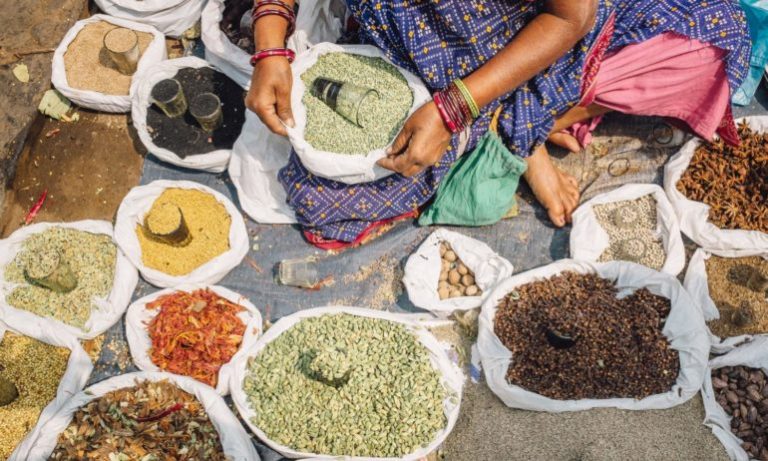

The GREEN Foundation is working to slow the rate of farmer suicides in India and improve conditions for farmers—especially women—whose traditional agricultural methods were stripped away by the Green Revolution. A 20th-century push by Western agronomists to decrease hunger in developing nations, the Green Revolution led to the introduction of higher-yield crops and technologies and caused rice and wheat production in India to jump significantly.
According to GREEN Foundation founding trustee Dr. Vanaja Ramprasad, the Green Revolution is “a misnomer to begin with,” because it came at the expense of time-honored farming techniques and farmers’ economic security, which the GREEN Foundation has been working since the 1990s to address through community seed banks and educational outreach programs.
“[The Green Revolution] was based on high chemical input to realise higher yields, and promoted monocultures to feed the growing populations,” Ramprasad says. “The Green Revolution focused on two crops—rice and wheat—thereby destroying all diversity of food crops. All diversity needed for sustainable farming also disappeared, with more and more chemical use.”
The Green Revolution also made agriculture more expensive for farmers in countries like India, as they became tied to large foreign agriculture companies for seeds, herbicides, and fertilizers necessary for growing high-yield crops. Ramprasad explained that farmers who never previously would have borrowed from banks became indebted to them due to the increasing expense of agriculture—and farmers whose crops failed were unable to repay their debts, leading to an increasing rate of male farmer suicides. Women then became responsible for carrying on the family farms and providing for their families.
More than 12,000 farmers and agricultural laborers have taken their own lives every year since 2013, according to the Times of India. Ramprasad said the Indian government provides a stipend to widowed wives, but she added that in certain cases, a sizable portion of this sum is withheld until the family’s children come of age. And, according to a 2017 Oxfam report, since women in India “are not recognized as farmers and do not own land, they have limited access to government schemes and credit, restricting their agricultural productivity.”
Because of this, many of the GREEN Foundation’s programs are specifically oriented toward supporting female farmers in India, where Ramprasad says the government’s National Sample Survey Office found that 79 percent of women were engaged in agriculture activities in 2010. She says women were involved in all aspects of the grain production process, including seed selection, sowing, fertilizing, and harvesting. “Women also take on almost all the primary processing, storage, and cooking of food as subsistence farmers,” Ramprasad says.
In India, a significant wage gap exists between male farmers and female farmers, which adds another layer to the challenges already faced by women filling both traditionally male and female agricultural and household roles.
“The gender gaps in literacy, health status, and low levels of asset ownership of women in general, and rural poor in particular, are resultant outcomes of the deep-rooted discrimination that rural women face,” Ramprasad said. She explained that expansion in women’s wages typically only occurs in the service sector, not in production-sector jobs like farming.
The primary method the GREEN Foundation employs to restore indigenous seed varieties and farming methods to India is its network of community seed banks in the southwestern state of Karnataka. Farmers can borrow seeds to grow, under the condition that they return double the amount of seeds they were lent at a later date. Many seed bank members are women, and the foundation trains them on seed selection, storage, and conservation, as well as record-keeping and monitoring farming methods used by the borrowers.
“When the Foundation starts work, the work will begin with a seed fair requesting the farmers to bring all the indigenous varieties they have kept and display them,” Ramprasad says. “This way, farmers exchange the seeds and start experimenting to grow them. If there is enough interest from farmers, the location is identified as a center for conservation.”
The Foundation’s seed banks across Karnataka contain upwards of 100 different varieties of seeds, and the foundation says 2,250 households have been impacted by the seed bank program. Now, the state government of Karnataka funds the establishment of more seed banks. The GREEN Foundation has also helped establish close to 1,000 community kitchen gardens across Karnataka, which help families access different types of vegetables that may be too expensive to grow on their individual farms.
“It was very important to restore the seeds that belonged to the farmers, since this was the bedrock of food security in the country,” Ramprasad says.
Nggak Nyangka! Hidup Gue Berubah Total! Gue bukan siapa-siapa. Cuma anak kos biasa yang kerja serabutan buat nutup biaya hidup… Read More
What is the Main Cause of a Heart Attack? What is its Solution? A heart attack is the blockage of… Read More
In the vast economic arena, one term that often takes center stage, inciting extensive debates and discussions, is the "debt… Read More
De-Dollarization: The Changing Face of Global Finance The financial landscape is in a state of flux, with an intriguing economic… Read More
The curtains closed on a dramatic Bundesliga season with Bayern Munich standing tall once again, clinching their 11th straight title.… Read More
The Unfolding Story of Celine Dion's Health In recent news that has left fans across the globe stunned, iconic singer… Read More